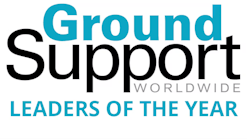Commercial aviation is a complex industry with many variables. Within each segment of the industry, ground handling included, there are many nuiances.
For example, just as the needs for ground support equipment (GSE) can vary from one ground service provider to another so too can the solutions for funding GSE.
“Some customers require short-term rentals until they receive delivery of newly ordered equipment, while some customers require long-term leases which are used to permanently fill their operational needs,” says Nicole Romeo, who is a certified lease and finance professional and serves as airport maintenance equipment and ground support equipment sales manager at Fortbrand Services.
“This information is discovered when we sit down with our customers during the onset of their project, allowing us to carefully craft the appropriate lease/maintenance solution that meets their specific need.”
While Fortbrand specializes in GSE and airfield maintenance equipment, as well as equipment maintenance and financing, CSI Leasing provides equipment lifecycle and finance solutions. This range of options provides flexibility for ground service providers to utilize the equipment needed in each individual operation.
Leasing vs. Renting
Leasing is one of the most common options to finance GSE.
Lease options generally range from 12 months up to 10 years. If the term is shorter than 12 months, equipment rental may be a better option.
Jeff Clark, GSE leasing specialist at CSI Leasing, notes equipment rental on a month-to-month basis with no long-term obligation to the renter will generally be more costly than leasing or financing since there is no commitment, or the commitment is low.
“Leasing is a financial option whereby the customer pays for the use of equipment without bearing the risk of full ownership or having to outlay any initial capital investment,” Romeo adds.
The customer, known as the lessee, pays for the use of an asset over a determined amount of time.
At the end of lease term, the customer has multiple end-of-term lease options. They include returning the equipment, continuing to lease the equipment or purchasing the equipment for the fair market value.
Romeo says the terms of the initial contract can be short term or long term, with the most common terms ranging between 6 months to 84 months.
Fair Market Value vs Capital Leases
According to Clark, two popular types of leases are fair market value (or operating) leases and capital leases.
A fair market value (FMV) lease allows the customer to use the equipment for a pre-arranged time for a fixed monthly payment. At the end of the term, the lessee has the option to buy any or all of the equipment on lease at its then-current fair market value, return the equipment or extend the agreement for an agreed upon term and rental rate.
“The leasing company invests a residual value in the equipment, so the customer effectively pays less than the original equipment cost over the initial lease term. Leasing companies are able to do this since they own the equipment at the end of lease and can then refurbish and resell it in the secondary market, if they have the means to do so. With an FMV lease, the leasing company takes the risk of technological and economic obsolescence during the lease term and the lessee pays only for its period of usage,” Clark says.
He adds at CSI, company representatives find that the fair market value and rental structures are the most common in the industry and satisfy most needs.
“Terms are flexible under the fair market value option and can almost always accommodate a customer’s needs,” Clark says. “Our customers typically request monthly or quarterly payment structures.”
CSI includes equipment disposal in fair market value leasing, which Clark says provides a significant savings in total cost of ownership savings.
“The customer doesn’t need to worry about stockpiling or selling decommissioned GSE, our subsidiary that specializes in the secondary market handles all of these services in-house,” he explains.
Looking at a capital lease, also known as a $1 buyout, Clark explains this is similar to a loan where the customer owns the equipment at the end of the lease for a nominal payment. Typically, he says a capital lease will have a higher monthly payment compared to a FMV lease.
Both FMV and capital lease structures fix the rental rate for the duration of the lease term, so the lessee is protected from volatile interest rate environments. However, Clark says changes in interest rates can affect rental rates in the future in the event the lease is extended, unless the lease specifies a fixed rate for an extension.
“Fair market value leases work best for companies that require flexibility in their GSE fleet. If needed, equipment can be moved to other locations, upgraded during the term of the lease, or extended if the life of the equipment will be longer than initially expected at the time the contract was initiated,” says Clark.
Leasing is also beneficial for organizations with international locations, he says, noting that CSI leases in more than 50 countries, giving customers a centralized way to manage their GSE worldwide.
Different leasing companies may use different terms and have different options.
Both Fortbrand and CSI (through its alliance with Tandem) offer sale leasebacks and sale leasebacks with refurbishment.
A sale leaseback is when a company purchases a customer’s existing company-owned equipment for a set price and leases it back to the customer. A refurbishment release (or sale leaseback with refurbishment) is when a company purchases a customer’s existing company-owned GSE for a set price, refurbishes it based on an agreed upon scope of work and releases the refurbished GSE back to the customer.
Fortbrand also has a turnkey eGSE lease, which includes customizable battery options and charging infrastructure.
“At Fortbrand, we view our lease offering as more than just a commodity or a solution that we dictate to the customer. In conjunction with our customers’ input, we craft value-added solutions to meet their needs which include budgetary needs, contract lengths, contractual documentation terms and the ability to renegotiate during the mid-term or end-term,” says Romeo.
Financing To Include Maintenance
Financing can be structured to include GSE maintenance and servicing.
Through a strategic alliance with Tandem GSE, CSI can provide organizations with factory-trained technicians that can solve many issues that often occur in the field.
“We also provide an option for Tandem to handle all scheduled and unscheduled maintenance of equipment both during and outside the period of warranty,” says Clark.
Fortbrand manages and performs preventative maintenance and offers different levels of management and maintenance offerings tailored to meet customer needs.
“Customers who rely on us to maintain their leased GSE, generally have a better customer experience, as they have increased daily dependability, instant access to maintenance records, and in some cases, if needed, access to back-up equipment,” says Romeo.
Considerations Before Signing a Contract
Before making a final decision and signing a financial agreement, Romeo and Clark advise taking the following considerations into account.
At the end of the day, Clark says, leasing is part of an overall equipment management strategy.
“It helps organizations maximize their budget, provides predicable payments, and offers a great deal of flexibility,” he says.
However, Clark adds it’s important for any organization thinking about leasing to do their homework and ask the right questions before choosing a leasing company.
“Some leasing companies charge administrative, restocking or end-of-lease fees, so it’s important to consider this when calculating the overall cost,” says Clark.
Other questions to ask he says include: “Do they have fair end-of-lease terms? Can I make asset-level decisions? Do they have international capabilities?”
“Taking time to find the right leasing company for you will pay off in dividends down the road,” Clark says.
Romeo points out transparency is the most important aspect of entering into a leasing arrangement.
“We recommend our potential customers ask as many questions as possible. In addition to the payment, be sure to understand all the terms and conditions that could affect the total cost of leasing,” Romeo says.






